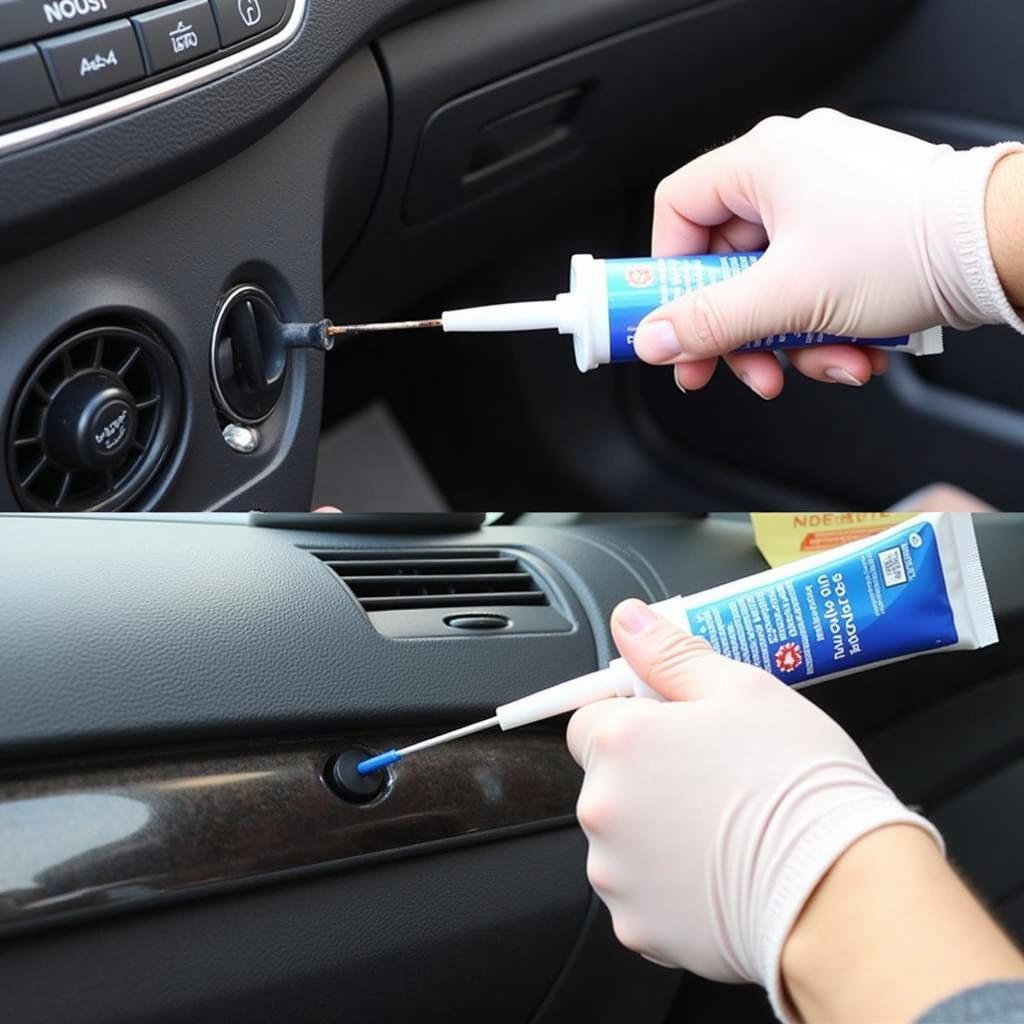A malfunctioning car AC system can quickly turn a comfortable drive into a sweaty ordeal. Often, the culprit is an air conditioning leak. Knowing how to repair an air conditioning leak in a car can save you money and keep you cool, especially during those hot summer months. This guide will walk you through the process of identifying and fixing those pesky AC leaks.
Finding and fixing a car air conditioning leak can seem daunting, but with the right guidance, it’s a manageable task. First, you’ll need to identify the type of leak. Common sources include the compressor, condenser, evaporator, or hoses and connections. Each component requires a slightly different approach to repair. Locating the specific source of the leak is crucial for effective air conditioning leak repair car.
Pinpointing the Source of Your Car AC Leak
Before you start tearing apart your car’s AC system, you need to know where the leak is coming from. A few simple techniques can help you locate the problem area. One common method involves using a UV dye. You inject this dye into the system, and it will fluoresce under a UV light, highlighting the leak’s location. You can find car air conditioning leak repair kits that include this dye along with other necessary tools. Alternatively, a professional mechanic can perform a leak test using electronic detectors. These detectors are highly sensitive and can pinpoint even the smallest leaks. Considering the car air conditioning leak repair cost, it might be worthwhile to consult a professional, especially if you’re not comfortable working with automotive systems.
Another method is to listen for hissing sounds. A hissing sound near the AC components could indicate a leak. Additionally, check for oily residue around the connections and components. This residue can suggest a refrigerant leak. Finally, if your AC system isn’t cooling effectively, or if you notice a strange smell when you turn it on, these are further indicators of a potential leak.
Common Car AC Leak Repair Procedures
Once you’ve located the leak, the next step is to repair it. Depending on the source and severity of the leak, the repair process will vary. For minor leaks in hoses or connections, a sealant might be sufficient. For more substantial leaks, replacing the damaged component is usually necessary. If the leak is in the compressor, condenser, or evaporator, it’s often best to consult a professional. These components are more complex and require specialized tools and knowledge to repair.
Repairing a Leak in the AC Hose
If the leak is in a hose, you may be able to repair it yourself using a specialized sealant. First, clean the area around the leak thoroughly. Then, apply the sealant according to the manufacturer’s instructions. Allow the sealant to dry completely before recharging the AC system. Check for [car air conditioning leak repair kit] online that will have everything you need for this job. You can also check out [air conditioning leak repair car] for further options.
Replacing a Damaged AC Component
If a component needs replacement, you can find replacement parts at most auto parts stores. The process for replacing a component will vary depending on the specific part and your car’s make and model. Refer to your car’s repair manual or consult a professional for guidance.
Preventing Future AC Leaks
Regular maintenance is key to preventing future AC leaks. Have your AC system inspected annually by a qualified technician. They can check for leaks and other potential problems and address them before they become major issues. Keep the system clean and free of debris, and ensure that the refrigerant levels are correct. You can search for [car air conditioning leak repair near me] to find a reputable repair shop in your area. For an estimate of the repair costs, explore [car air conditioning leak repair cost] resources online. For more complicated repairs, you could also consider [air conditioning car leak repair] services provided by specialist mechanics.
Conclusion
Knowing how to repair an air conditioning leak in a car can save you time and money. By understanding the different types of leaks, how to locate them, and the necessary repair procedures, you can keep your car’s AC system running smoothly. However, if you’re unsure about any part of the process, don’t hesitate to consult a qualified technician. Keeping your car cool and comfortable is worth the effort.
FAQs
-
What are the most common causes of car AC leaks? Age, wear and tear, and damage from road debris are common causes.
-
How much does it cost to repair a car AC leak? The cost depends on the location and severity of the leak. Minor repairs might cost a few hundred dollars, while major repairs could be more expensive.
-
Can I repair a car AC leak myself? Minor leaks in hoses or connections can sometimes be repaired with a sealant. However, more complex repairs are best left to professionals.
-
How often should I have my car’s AC system inspected? It’s recommended to have your AC system inspected annually.
-
What are the signs of a car AC leak? Weak airflow, strange smells, hissing sounds, and oily residue around components can indicate a leak.
-
What is the best way to locate a car AC leak? Using a UV dye or an electronic leak detector are effective methods for pinpointing leaks.
-
How can I prevent future car AC leaks? Regular maintenance, keeping the system clean, and ensuring proper refrigerant levels can help prevent leaks.
Need assistance with your car’s AC? Contact us via WhatsApp: +1(641)206-8880, Email: [email protected]. Our customer support team is available 24/7.



